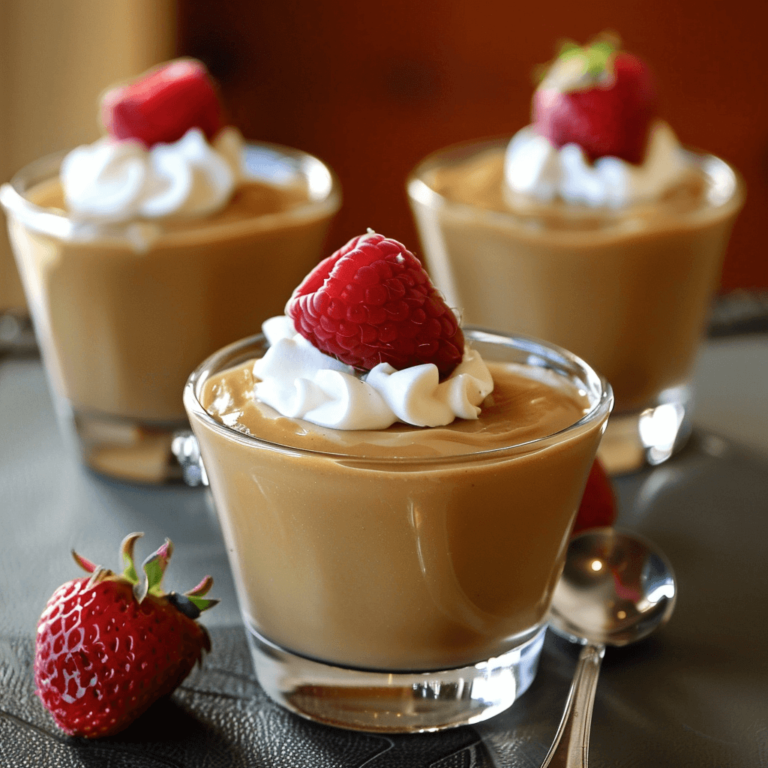Butterscotch pudding is a classic dessert that evokes nostalgia and comfort with every creamy, rich spoonful. This timeless treat combines the deep, caramel-like flavors of brown sugar and butter with a silky smooth texture that melts in your mouth. Perfect for any occasion, whether it’s a family dinner, a festive celebration, or a simple weeknight treat, butterscotch pudding offers a delightful end to any meal. This recipe breaks down the process into easy-to-follow steps, ensuring you achieve a perfect pudding every time.
Ingredients:
- 1/2 cup unsalted butter
- 1 cup dark brown sugar, packed
- 3 tablespoons cornstarch
- 1/2 teaspoon salt
- 2 1/2 cups whole milk
- 1/2 cup heavy cream
- 3 large egg yolks
- 2 teaspoons vanilla extract
- Whipped cream, for garnish (optional)
- Shaved chocolate or butterscotch chips, for garnish (optional)
Instructions:
Step 1: Prepare the Butterscotch Base
- Melt the Butter:
Begin by melting the unsalted butter in a medium saucepan over medium heat. Use a pan with a heavy bottom to prevent burning and ensure even cooking. Stir occasionally to help the butter melt evenly. - Add Brown Sugar:
Once the butter is fully melted, add the packed dark brown sugar. Stir the mixture continuously until the sugar dissolves and combines with the butter, forming a smooth, thick mixture. This step is crucial as it forms the foundation of the butterscotch flavor. - Cook the Mixture:
Continue to cook the butter and sugar mixture for about 3-5 minutes, or until it begins to bubble and turn a deep amber color. Be careful not to let it burn. The goal is to achieve a rich, caramelized flavor without crossing into bitterness.
Step 2: Combine Dry Ingredients and Milk
- Mix Cornstarch and Salt:
In a small bowl, whisk together the cornstarch and salt. This combination will help thicken the pudding and enhance its flavor. - Add Milk and Cream:
Gradually whisk in the whole milk and heavy cream to the cornstarch mixture, ensuring there are no lumps. It’s essential to combine these ingredients thoroughly before adding them to the saucepan to achieve a smooth pudding texture.
Step 3: Cook the Pudding
- Combine Mixtures:
Slowly pour the milk and cream mixture into the saucepan with the butterscotch base, whisking constantly. This step helps prevent the formation of lumps and ensures a uniform consistency. - Heat and Thicken:
Increase the heat to medium-high and continue to cook the mixture, whisking constantly, until it begins to thicken. This process can take about 5-7 minutes. The pudding should start to coat the back of a spoon, indicating it’s ready for the next step.
Step 4: Temper the Eggs
- Whisk Egg Yolks:
In a separate bowl, lightly whisk the egg yolks. Tempering the egg yolks is essential to prevent them from curdling when added to the hot pudding mixture. - Temper the Egg Yolks:
Gradually add a small amount of the hot butterscotch mixture to the egg yolks, whisking continuously. This step raises the temperature of the yolks slowly, preventing them from scrambling. - Combine Mixtures:
Once the egg yolks are tempered, slowly pour the egg mixture back into the saucepan, whisking constantly. This step ensures the pudding remains smooth and creamy.
Step 5: Final Cooking and Flavoring
- Thicken the Pudding:
Continue to cook the pudding over medium heat, stirring constantly, until it thickens further. This process should take an additional 2-3 minutes. The pudding is ready when it reaches a thick, custard-like consistency. - Add Vanilla Extract:
Remove the saucepan from heat and stir in the vanilla extract. This addition enhances the butterscotch flavor and adds a pleasant aroma to the pudding.
Step 6: Chill and Serve
- Transfer to Containers:
Pour the hot pudding into individual serving dishes or a large bowl. Allow it to cool slightly before covering with plastic wrap. Place the plastic wrap directly on the surface of the pudding to prevent a skin from forming. - Chill:
Refrigerate the pudding for at least 2 hours, or until fully chilled. The pudding will continue to thicken as it cools, achieving its final texture. - Garnish and Serve:
Before serving, garnish the pudding with a dollop of whipped cream and a sprinkle of shaved chocolate or butterscotch chips, if desired. These additions add a touch of elegance and extra flavor to the dessert.
Conclusion
Butterscotch pudding is a decadent and comforting dessert that brings a touch of old-fashioned charm to any table. Its rich, caramelized flavor and velvety texture make it a favorite among both children and adults. This recipe, with its detailed instructions, ensures that you can recreate this classic treat with ease and confidence. Whether enjoyed on its own or adorned with your favorite toppings, butterscotch pudding is sure to become a beloved staple in your dessert repertoire. So go ahead, indulge in this delightful treat and savor the sweet satisfaction of homemade butterscotch pudding.


